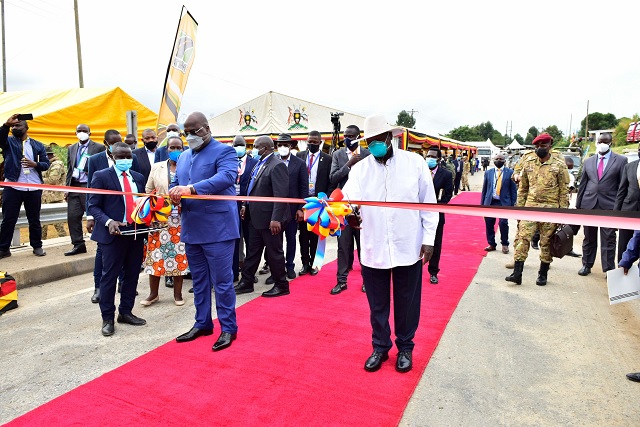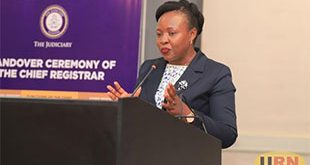
Kampala, Uganda | THE INDEPENDENT | The Democratic Republic of Congo (DRC) was Uganda’s number one source of trade surplus in 2020 according to Bank of Uganda trade statistics, and road projects launched yesterday by President Museveni and his DR Congo counterpart Felix Antoine Tshisekedi will likely further boost Uganda’s trade with DRC.
Uganda earned $241 million in trade surplus from DRC in 2020, and $177 million estimated informal trade exports that push the figure to $418 million trade earnings. This makes DRC Uganda’s number one source of trade surplus.
Trade surplus refers to the amount by which the value of a country’s exports exceeds the value of imports.
Second to DRC is South Sudan. Uganda earned $276 million (trade surplus) from goods exported to the country, slightly above DRC formal trade earnings. The $80 million estimate of informal trade exports to South Sudan is almost half of DRC’s estimate.
For countries such as Kenya and Tanzania, Uganda’s other main trading partners in the region, Uganda’s export earnings are subdued by a large import bill, tilting the balance to trade deficit. For instance, Uganda exported goods worth $465 million in 2020 to Kenya but imported goods worth $809 million. This means Uganda’s trade deficit with Kenya was more than $300 million in 2020.
Uganda exported goods worth $95 million to Tanzania in 2020 and imported goods worth $772 million, translating into trade deficit of almost $700 million. The Rwanda market was decimated by border closure in 2019. In 2019, Uganda exported goods worth $194 million to Rwanda and the value of exports diminished to $5 million in 2020, a year after the border was closed according to statistics from Bank of Uganda.
Such trade statistics make Uganda’s investment infrastructure in eastern DRC ‘tick’. Finance Minister Matia Kasaija last month, speaking at media center during launch of the budget month activities, described DRC a “huge sleeping market.” Uganda investment in the country is strategic, he said.
Kasaija revealed that a legislator had described him as “a stupid man” for going to construct roads in DRC yet he had told the legislator that there is no money to build a road in his constituency.
Africa Kiiza, a trade negotiations and policy analyst at Southern and Eastern Africa Trade Information and Negotiations Institute (SEATINI) says DRC market has become vital for Uganda given Rwanda’s failure to reopen the border and Kenya’s recent schemes to block Uganda products from entering its market.
“We classify some markets as troubled,” Kiiza said in a recent interview. “Rwanda and South Sudan are classified as troubled. Kenya is also starting to show signs of becoming a troubled market. Amidst these shifting geopolitical aspects, DRC market becomes important.”
But Kiiza warns; “It is not automatic that when you construct a road in Congo which is now our biggest trading neighbor, that the benefit that accrues will be felt by all. We can continue having increased trade without benefits.”
Kiiza says government should put in place mechanisms for maximum utilization of DRC market. “Should we not utilize this market, it’s the tax payers to lose,” he said.
Three roads (330 kilometers long) will be constructed. They are: Nebbi-Goli Mahagi-Bunia (190kms), Bunia-Bogoro-Kasenyi (55km) and Rwebisengo-Budiba-Buguma-Nyiyapandam, including Budiaba Bridge across River Semuliki (49km).
Uganda will contribute 20 percent of the total cost of the projects while the rest will be paid by DRC. Museveni during the launch said, “These projects will cause tremendous social-economic transformation of the lives of the people in the two countries. People of DR Congo and Uganda are interlinked and have existed as neighbors since time memorial.”
DRC’s Tshisekedi said the road project will boost the DRC economy and improve trade relations between the two countries. He said the two countries should strengthen relations in other sectors such as security and agriculture.
Joining EAC
DRC could soon be admitted to the East Africa Community, expanding regional organization market by 87 million people which is DRC’s population. DRC as a country shares more borders with EAC member countries.
EAC heads of state summit earlier this year directed the Council of Ministers to undertake the verification mission to Kinshasa and report to the next summit. The next summit will be at the end of this year or earlier next year.
If interlinked with DRC more than other EAC countries, Uganda stands to reap big from its market when DRC is fully admitted into the EAC.
*****
URN
 The Independent Uganda: You get the Truth we Pay the Price
The Independent Uganda: You get the Truth we Pay the Price



